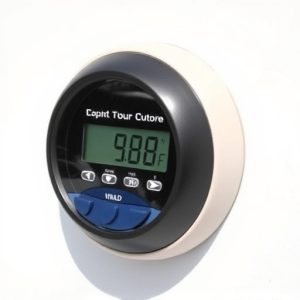Secure Splashes: Essential Guide to Inground Pool Alarm Systems
Swimming pool alarms are non-negotiable safety devices for inground pools, serving as both a deterr…….
Swimming pool alarms are non-negotiable safety devices for inground pools, serving as both a deterrent to unauthorized access and an immediate alert system for potential drowning risks. These alarms come in two types: passive, which monitor the entire pool area, and active/perimeter alarms, which guard against intrusion or falls by signaling when the pool's boundary is breached. When selecting a swimming pool alarm for inground pools, consider detection technology, coverage range, ease of installation, user-friendliness, and system integration with home automation for optimal security. Regular maintenance, including weekly testing, battery checks, and clearing of obstructions, is vital to ensure the alarm's functionality. Proper placement around the pool perimeter and entry points enhances protection, as does educating users about the system's purpose and operation. By adhering to these practices, swimming pool alarms for inground pools significantly bolster safety measures, potentially preventing tragic accidents and ensuring a secure swimming environment.
Swimming pools offer a refreshing retreat and recreational space for families and communities. However, safety remains paramount, especially with the rise of inground pools. This article delves into the critical topic of swimming pool protection, focusing on robust security systems. We explore the necessity of these systems, the types of alarms available specifically for inground pools, and how to select and maintain an effective alarm. By understanding and implementing the best practices for pool safety with alarms, you can ensure a safe and enjoyable environment for all.
Understanding the Importance of Swimming Pool Protection Systems
When it comes to safeguarding your inground pool, installing a comprehensive protection system is paramount. Swimming pool alarms for inground pools play a critical role in enhancing safety measures by promptly signaling unauthorized access or potential dangers. These systems are designed to detect motion within the water or at the pool perimeter, activating audible alerts that can deter accidental or intentional entries by individuals who may not be familiar with swimming or lack the necessary safety skills. By integrating these alarms into your pool’s safety protocol, you create a more secure environment, especially for homes with children or pets. It’s not just about preventing unsupervised access; it’s about layering defense mechanisms to ensure that every precaution is taken to protect those using the pool.
The importance of selecting the right swimming pool alarms for inground pools cannot be overstated. These systems are available in various types, including surface wave detectors, pressure-sensitive mats, and motion sensors. The choice depends on the specific layout and size of your pool, as well as the level of security you wish to achieve. Advanced models offer remote monitoring capabilities, allowing pool owners to receive notifications on their smartphones or other devices. This feature provides peace of mind, knowing that even when you’re away from home, your pool is under watchful eyes. By understanding the importance of these systems and choosing the appropriate one for your inground pool, you are taking a proactive step towards ensuring the safety and well-being of all who enjoy your pool.
Types of Swimming Pool Alarms for Inground Pools
Swimming pool alarms are integral components for ensuring the safety and security of inground pools, particularly when they are unattended. These systems serve as a deterrent to unauthorized access and provide immediate notification in the event of an intrusion or potential drowning incident. There are primarily two types of swimming pool alarms designed specifically for inground pools: passive and active/perimeter alarms. Passive alarms detect any movement within the pool area, triggering an alarm when motion is detected. These are ideal for protecting against unauthorized use or for monitoring the pool when it’s in use. On the other hand, active or perimeter alarms are designed to detect when a person, especially a child, enters the pool enclosure. They create an invisible barrier around the pool’s perimeter, which, when breached, activates the alarm. Both types of alarms can be further categorized into audible and visual/audible systems, with the former emitting a loud noise to alert nearby individuals and the latter incorporating cameras along with sound-based alerts to enhance monitoring capabilities. It’s crucial for pool owners to assess their specific needs and choose the most appropriate swimming pool alarm for inground pools to ensure the highest level of safety and peace of mind.
Features to Consider When Choosing a Pool Alarm System
When safeguarding your inground pool, it’s crucial to invest in a robust pool alarm system that offers both peace of mind and effective protection. Swimming pool alarms for inground pools come with a variety of features tailored to different needs and preferences. Among the key aspects to consider are the detection technology and range. Opt for systems that utilize state-of-the-art sensors capable of detecting unauthorized access or falls into the water. The range of the alarm should cover your entire property, ensuring immediate notification upon any activity within or around the pool area.
Additionally, the ease of installation and user-friendliness are important factors. A system that can be easily installed without the need for extensive wiring or technical expertise will save you time and effort. User-friendly interfaces allow for quick setup and straightforward operation. Moreover, consider systems that integrate with other home security measures for a comprehensive safety solution. This integration enables seamless monitoring and can alert you through existing smart home systems, providing a unified approach to safeguarding your inground pool and its surroundings. Always ensure the system complies with local regulations and standards for pool safety, ensuring full functionality and legal compliance. With careful consideration of these features, you can select a pool alarm system that will effectively protect your family and loved ones while enjoying your inground pool.
Installing and Maintaining Your Pool Alarm System
When securing your inground pool, installing a reliable alarm system is paramount for safety and peace of mind. Swimming pool alarms for inground pools serve as a critical layer of protection, designed to detect unauthorized access or accidental falls into the water. Upon installation, it’s crucial to familiarize yourself with the different types available—surface wave motion sensors, magnetic beam sensors, or pressure-based detectors—each offering distinct advantages tailored to various pool designs and environments. Proper placement of these alarms is essential to ensure full coverage around the pool perimeter, and they should be set up in accordance with manufacturer guidelines and local regulations.
Maintaining your swimming pool alarm system involves regular checks to ensure its functionality and sensitivity settings are optimal. Testing the alarm weekly helps to guarantee immediate response in case of an actual intrusion or accidental immersion. Battery backups, if applicable, should be regularly inspected and replaced as necessary to prevent false disarmings during power outages. It’s also important to keep the system free from debris and foliage that could potentially obstruct its sensors or emit incorrect signals. By adhering to a routine maintenance schedule and staying informed about the latest advancements in pool alarm technology, you can effectively safeguard your inground pool and protect those using it.
Best Practices for Ensuring Pool Safety with Alarms
Swimming pool alarms serve as a critical layer of safety for inground pools, acting as a deterrent against unauthorized access and drowning incidents. To maximize the effectiveness of these devices, it is crucial to select alarms that are compatible with your specific pool setup and to install them according to the manufacturer’s guidelines. The best practices for ensuring pool safety with alarms begin with their strategic placement around the pool perimeter, including at entry points, where they can detect any disturbances in the water’s surface caused by a fall or an unauthorized user.
Once installed, regularly test your inground pool alarms to ensure they are functioning correctly. This involves checking batteries, sensors, and connection to the alarm unit itself. Additionally, consider alarms that connect to a central monitoring system if you wish to have real-time alerts sent to your mobile device or a designated caregiver. Educating all users of the pool about the purpose and operation of these alarms is also essential for maintaining a safe swimming environment. Regular maintenance and prompt replacement of any malfunctioning components are key to sustaining an uninterrupted safety protocol around your inground pool. By adhering to these best practices, you can significantly reduce the risk of accidental drownings and enhance the overall security of your swimming pool area.


